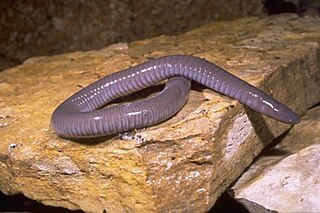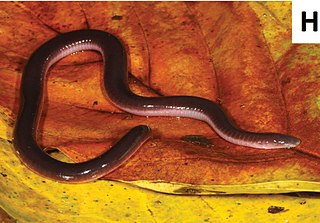
Caecilians are a group of limbless, vermiform (worm-shaped) or serpentine (snake-shaped) amphibians with small or sometimes nonexistent eyes. They mostly live hidden in soil or in streambeds, and this cryptic lifestyle renders caecilians among the least familiar amphibians. Modern caecilians live in the tropics of South and Central America, Africa, and southern Asia. Caecilians feed on small subterranean creatures such as earthworms. The body is cylindrical and often darkly coloured, and the skull is bullet-shaped and strongly built. Caecilian heads have several unique adaptations, including fused cranial and jaw bones, a two-part system of jaw muscles, and a chemosensory tentacle in front of the eye. The skin is slimy and bears ringlike markings or grooves and may contain scales.

Ichthyophis beddomei is a species of caecilian in the family Ichthyophiidae. This species is distributed widely in the Western Ghats in southern India. The nominal species might be a composite of several cryptic species. It is also known as the yellow-striped caecilian, Beddome's caecilian, or Nilgherries caecilian.

Ichthyophis garoensis, the Garo Hills caecilian, is a species of caecilian found in Assam and Meghalaya in north-eastern India. The Husain's caecilian Ichthyophis husaini was until 2016 considered a separate species. It is a subterranean caecilian that lives in the moist leaf-litter of tropical forests. It is typically found close to streams and other waterbodies.
Uraeotyphlus malabaricus is a species of caecilian in the family Ichthyophiidae. It is endemic to the Western Ghats of India and is known from its type locality, "Malabar" in Kerala, and from the Nilgiri mountains in Tamil Nadu. It is known with several common names: Malabar tailed caecilian, Nilgiris caecilian, Malabar caecilian, and white-lipped caecilian.
Gegeneophis carnosus is a species of caecilian found in Karnataka and Kerala states, India. Its common name Periah Peak caecilian refers to its type locality, though it is also known under names blind caecilian and pink blind caecilian.
Gegeneophis ramaswamii, common names Tenmalai caecilian, Tenmalai blind caecilian, Ramaswami's caecilian, and forest caecilian is a species of caecilian. It is endemic to the southern portion of the Western Ghats, India, and is recorded from Kerala and Tamil Nadu. The specific name ramaswamii honours L. S. Ramaswami, an Indian herpetologist.
Battersby's caecilian is a slender species of caecilian endemic to the Western Ghats, India. It has a flesh-coloured body, making it look very much like a large earthworm.

Chthonerpeton indistinctum is a species of caecilian in the family Typhlonectidae. It is found in northeastern Argentina, Paraguay, Uruguay, and southeastern Brazil. The common name Argentine caecilian has been coined for it.

Dermophis mexicanus, also known commonly as the Mexican burrowing caecilian or the Mexican caecilian, and locally as the tapalcua or tepelcua, is a species of limbless amphibian in the family Dermophiidae. The species is native to Mexico and Central America, where it burrows under leaf litter and plant debris.

Schistometopum thomense is a species of amphibian in the family Dermophiidae, endemic to São Tomé and Ilhéu das Rolas. It is found in most soils on São Tomé, from tropical moist lowland forests to coastal coconut plantations. It is absent only from the driest northern areas of the island. It is typically around 30 cm (12 in) in length, and is often bright yellow. The size of S. thomense can vary throughout São Tomé, however, and it is the only known caecilian to follow Bergmann's rule, which states that a decreasing temperature due to factors such as increasing altitude will cause an increase in the body size of endothermic vertebrate species. The island of São Tomé is a massive shield volcano, and it therefore has differing altitudes throughout the island, potentially resulting in the size diversity of S. thomense. This species may be referred to as the São Tomé caecilian, as the Agua Ize caecilian, or as the island caecilian, or by the local name of cobra bobo.

Siphonops annulatus, the ringed caecilian, is a species of caecilian in the family Siphonopidae from South America. It might have the broadest known distribution among terrestrial caecilian species.

Siphonops is a genus of caecilians in the family Siphonopidae, found in South America. All species are known to occur within Brazil, however, only S. hardyi and S. leucoderus are endemic to it. The native ranges of the other two known species, S. annulatus and S. paulensis, extend outwards into the surrounding countries of Argentina, Bolivia, and Paraguay. S. annulatus's range extends even further, stretching into Colombia, Ecuador, French Guiana, Guyana, Peru, Suriname, and Venezuela, and giving it perhaps the most widespread distribution of any single caecilian species.
Siphonops hardyi, or Hardy's caecilian, is a species of caecilian in the family Siphonopidae. It is endemic to southeastern Brazil where it occurs in the states of São Paulo, Rio de Janeiro, Espírito Santo, and Minas Gerais, possibly wider. This species lives in soil and under leaf litter or stones in primary forest, plantations, and rural gardens. It is a common species; it can locally suffer from infrastructure development but is not generally threatened.

Siphonops paulensis, or Boettger's caecilian, is a species of caecilian in the family Siphonopidae. It is found in northern Argentina, Paraguay, eastern Bolivia, and southern Brazil. It lives subterraneously in forests, savannas, shrublands, and grassland. It also adapts to anthropogenic disturbance and can even live in urban gardens. In fact these caecilians have even been recorded to breed and raise their young close to Santa Cruz, a highly populated city. It is a locally common species that is not facing major threats.

The Koh Tao Island caecilian is a species of amphibian in the family Ichthyophiidae found in Cambodia, Laos, Myanmar, Thailand, and Vietnam. Also known as the Ichthyophis bannanicus, the Banna caecilian, it is also found in southern China.

Ichthyophis supachaii, or Supachai's caecilian, is a species of caecilian in the family Ichthyophiidae found in Thailand's provinces of Nakhon Si Thammarat and Trang, and possibly Malaysia.
Rhinatrema is a genus of caecilians in the family Rhinatrematidae. Their common name is two-lined caecilians. The genus is known from the Guyanas and adjacent Brazil. Most Rhinatrema are known to inhabit and live in areas of tropical forests where there is an abundance of dense, dead vegetation matter.
Rhinatrema bivittatum, the two-lined caecilian, is a species of caecilian in the family Rhinatrematidae. It is found in Brazil, French Guiana, Guyana, and Suriname. Its natural habitats are subtropical or tropical moist lowland forests, rivers, and intermittent rivers.

Scolecomorphus kirkii is a species of caecilian in the family Scolecomorphidae. It is known from southern Malawi east of the Shire River, northern Mozambique, and Tanzania ; the known distribution is discontinuous but the species is expected to occur in the intervening areas.

The Siphonopidae are the family of common caecilians. They are found in Central and South America. Like other caecilians, they superficially resemble worms or snakes.













